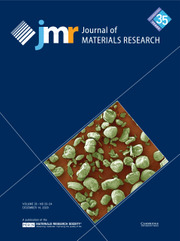Article contents
Defect structure evolution and abnormal grain growth during spark plasma sintering of nano WC–Si powders
Published online by Cambridge University Press: 12 April 2016
Abstract
The microstructural evolution during spark plasma sintering of ultrafine WC–1 wt% Si (n-WC–Si) is presented. At 1323 K (T < TmSi), extensive stacking faults on the  $\left\{ {10\bar 10} \right\}$ prismatic planes are observed. The defect microstructure can be described as a combined shear of
$\left\{ {10\bar 10} \right\}$ prismatic planes are observed. The defect microstructure can be described as a combined shear of  $1/6\left\langle {\bar 12\bar 13} \right\rangle$ on the prism planes and simultaneous out-diffusion of carbon through the faults to the interparticle boundaries. At temperatures near TmSi (1673 K), a large fraction of abnormally grown platelets is observed. These platelets contain a single planar defect on their basal planes, described by a
$1/6\left\langle {\bar 12\bar 13} \right\rangle$ on the prism planes and simultaneous out-diffusion of carbon through the faults to the interparticle boundaries. At temperatures near TmSi (1673 K), a large fraction of abnormally grown platelets is observed. These platelets contain a single planar defect on their basal planes, described by a  ${1 \mathord{\left/ {\vphantom {1 3}} \right. \kern-\nulldelimiterspace} 3}\left\langle {10\bar 10} \right\rangle$ translation of the carbon atoms across a Σ1 grain boundary (GB). Three factors contribute to the abnormally high density of platelets: (i) the low-temperature prismatic dislocations interact to form facet-roughening steps/kinks that act as nucleation sites, (ii) a liquid phase triggers an increased growth rate in the vicinity of the Si inclusions, and (c) the basal twin produces a re-entrant edge for 2D nucleation.
${1 \mathord{\left/ {\vphantom {1 3}} \right. \kern-\nulldelimiterspace} 3}\left\langle {10\bar 10} \right\rangle$ translation of the carbon atoms across a Σ1 grain boundary (GB). Three factors contribute to the abnormally high density of platelets: (i) the low-temperature prismatic dislocations interact to form facet-roughening steps/kinks that act as nucleation sites, (ii) a liquid phase triggers an increased growth rate in the vicinity of the Si inclusions, and (c) the basal twin produces a re-entrant edge for 2D nucleation.
Information
- Type
- Articles
- Information
- Copyright
- Copyright © Materials Research Society 2016
References
REFERENCES
- 7
- Cited by


